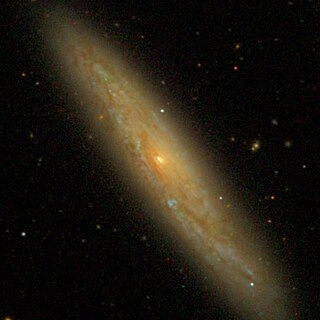NGC 3877
Galaxy in the constellation Ursa Major From Wikipedia, the free encyclopedia
NGC 3877 is a type Sc spiral galaxy that was discovered by William Herschel on February 5, 1788.[3] It is located below the magnitude 3.7 star Chi Ursae Majoris in Ursa Major.[3][4]

| NGC 3877 | |
|---|---|
 NGC 3877 (Sloan Digital Sky Survey) | |
| Observation data (J2000 epoch) | |
| Constellation | Ursa Major |
| Right ascension | 11h 46m 07.7281s[1] |
| Declination | +47° 29′ 40.369″[1] |
| Redshift | 0.002987[1] |
| Heliocentric radial velocity | 895 ± 4 km/s[1] |
| Distance | 50.5 ± 4.2 Mly (15.5 ± 1.3 Mpc)[2] |
| Apparent magnitude (V) | 12.1[1] |
| Characteristics | |
| Type | Sc[1] |
| Size | ~80,900 ly (24.80 kpc) (estimated)[1] |
| Apparent size (V) | 4'.4 × 0'.8[1] |
| Other designations | |
| IRAS 11434+4746, UGC 6745, MCG +08-22-002, PGC 36699, CGCG 243-004[1] | |
Supernova
One supernova has been observed in NGC 3877: SN 1998S (type IIn, mag. 15.2) was discovered by the BAO Supernova Survey on 3 March 1998.[5][6][3]
Environment
NGC 3877 is a member of the M109 Group, a group of galaxies located in the constellation Ursa Major that may contain over 50 galaxies. The brightest galaxy in the group is the spiral galaxy M109.[7][8][9]
See also
References
External links
Wikiwand - on
Seamless Wikipedia browsing. On steroids.
